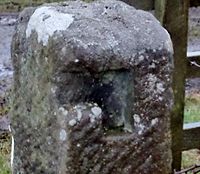Slip gate
[2] The stone used for the piers or stoups[2] ranges from heavy granite, slate or limestone through to lighter more easily worked red sandstone with varying degrees of dressing or finish and decorative embellishment.
[2] Slip gate piers at the National Museum of Rural Life's Wester Kittochside Farm were two-sided with L-shaped grooves on one side and square sockets on the other.
[5] The spars, bars or stangs[2] were usually made of wood and were first inserted into the socket before being slipped into the groove and then held firmly in place by a wedge.
[10] In Cumberland at Borrowdale a variant on the more common design is found made from slate with five or holes in each gate pier through which the wood spars were placed.
[6] especially as in times past footfall in the countryside was much greater with many more farm workers and also locals foraging for foods such as mushrooms, watercress, brambles, etc.
[6] They are mentioned by Robert Burns in his poem "Tam o Shanter": We think na on the lang Scots miles, The mosses, waters, slaps, and styles, That lie between us and our hame,







